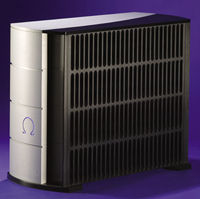| Columns Retired Columns & Blogs |
Classé Omega monoblock power amplifier
Have you ever had one of those conversations with your Significant Other that begins "But I thought you said..." and goes downhill from there? The Other's tone is condescending, and the body language—hands on hips, head slightly tilted—lets you know you're in big trouble.
 Trish and I had just closed on our dream house, which, for all its magic, necessitated a few compromises. One was that my listening room would have to double as our living room—or vice versa, depending on your point of view—so I had agreed to concentrate my reviewing on physically smaller gear. The ink was barely dry on that contract when the freight company called to arrange delivery of the Classé Omega monoblock power amps. Trish beat me to the phone. I could see her eyes blaze as the dispatcher cheerfully asked, "You do have a forklift to unload these, don't you? And a loading dock?" The hands went to the hips, the head tilted slightly, and out it came: "But I thought you said..." Oops.
Trish and I had just closed on our dream house, which, for all its magic, necessitated a few compromises. One was that my listening room would have to double as our living room—or vice versa, depending on your point of view—so I had agreed to concentrate my reviewing on physically smaller gear. The ink was barely dry on that contract when the freight company called to arrange delivery of the Classé Omega monoblock power amps. Trish beat me to the phone. I could see her eyes blaze as the dispatcher cheerfully asked, "You do have a forklift to unload these, don't you? And a loading dock?" The hands went to the hips, the head tilted slightly, and out it came: "But I thought you said..." Oops.
Fortunately, Trish is wonderfully understanding. When the time came to install the Omegas, she gamely helped me schlep the two flight cases, each weighing more than 200 lbs and about the size of a new Mini, into our listening—er, our living room, and lever the amps into place. She even managed a conciliatory "They really don't fit too badly there...but they are awfully big."
Two big towers
The Classé Omega is expensive, costing $25,000/pair. The Classé Omega is also drop-dead-gorgeous, massive, industrial-art chunk of aluminum and steel set off with a subtle mix of curves, contours, finishes, and textures. It's a vertical-format amp—imagine a normal monoblock stood on its side—of which the entire right side is a massive, cast-aluminum heatsink, softly contoured, and finished in velvety gloss-black. The left half has a satiny silver finish and is completely smooth, save for three horizontal grooves and the flush-mounted power switch near the upper front corner.
The front and back surfaces are split between silver and black, but each amp's two halves arc smoothly away from each other—one inward, one outward—creating a sculpted, biplanar façade. On the back side are two sets of WBT output binding posts, balanced (XLR) and unbalanced (RCA) inputs, and a high-current IEC receptacle for a Cardas Golden Cross AC cord (supplied). The front of the amp houses only a recessed, blue-backlit Greek letter omega, which blinks during the amp's turn-on/mute stage, and glows continuously in Operate mode. It glows red if a fault condition is detected.
The mono Omega's basic circuit resembles that of the stereo Omega (now discontinued), reviewed by Jonathan Scull in the March 1999 Stereophile—as well as that of any Classé power amp. The Omega is a true balanced configuration, using a pair of very-low-noise J-FETs as inputs and MOSFETs as drivers, with voltage amplification provided by a pair of bipolars after the J-FETS, and an array of 32 bipolar output transistors following the MOSFETs. The idea is to use the fast-reacting J-FET and MOSFET transistors to control the "heavy voltage or current-amplifying bipolar transistors," as Classé describes them.
After that, however, the Omega mono's design philosophy and implementation are completely different from the stereo versions, according to Classé's Armin Gschwendtner. Whereas the stereo version used "more of an old-school type design," he says, "with banks of output transistors running down the side of the heatsink, the monos, in contrast, use big, flat T220-type packages, which provide much better heat dissipation and management. The regulation too, in the monos, is way beyond what we did with the stereo amp. In the Omega monos, there's one regulator IC per output device, which adds tremendous stability and nearly unlimited power output." The new design philosophy is already working its way down into Classé's newer products, including the Omicron mono and, interestingly enough, the CAM-350 mono, which I greatly admired in the January 2001 Stereophile.
What's more, although the Omega mono's rated output of 500W is only slightly more than the stereo version's 450Wpc, a glance at the spec sheet suggests that the mono has a lot more muscle backing up its rating. For starters, there are the 32 output transistors vs the stereo version's 16 per channel. Similarly, the mono has a much beefier power supply, with 64 power-supply capacitors supplying 358,000µF instead of the stereo's 90,000µF per side, and a 3000VA instead of a 2500VA toroidal transformer. Can you say "overkill"?
And how about 4kW into a 1 ohm load? Nor is that massive heatsink mere decoration. It allows the 32 output transistors, and the 32 identical transistors used to regulate the power supply, all to be kept well within their linear operating regions. Although the Omega runs in pure class-A up to 30-35% of its rated output, essentially covering almost any real-world listening situation, my review samples were never more than warm to the touch, even after an entire day of intense, high-volume listening.
- Log in or register to post comments




































